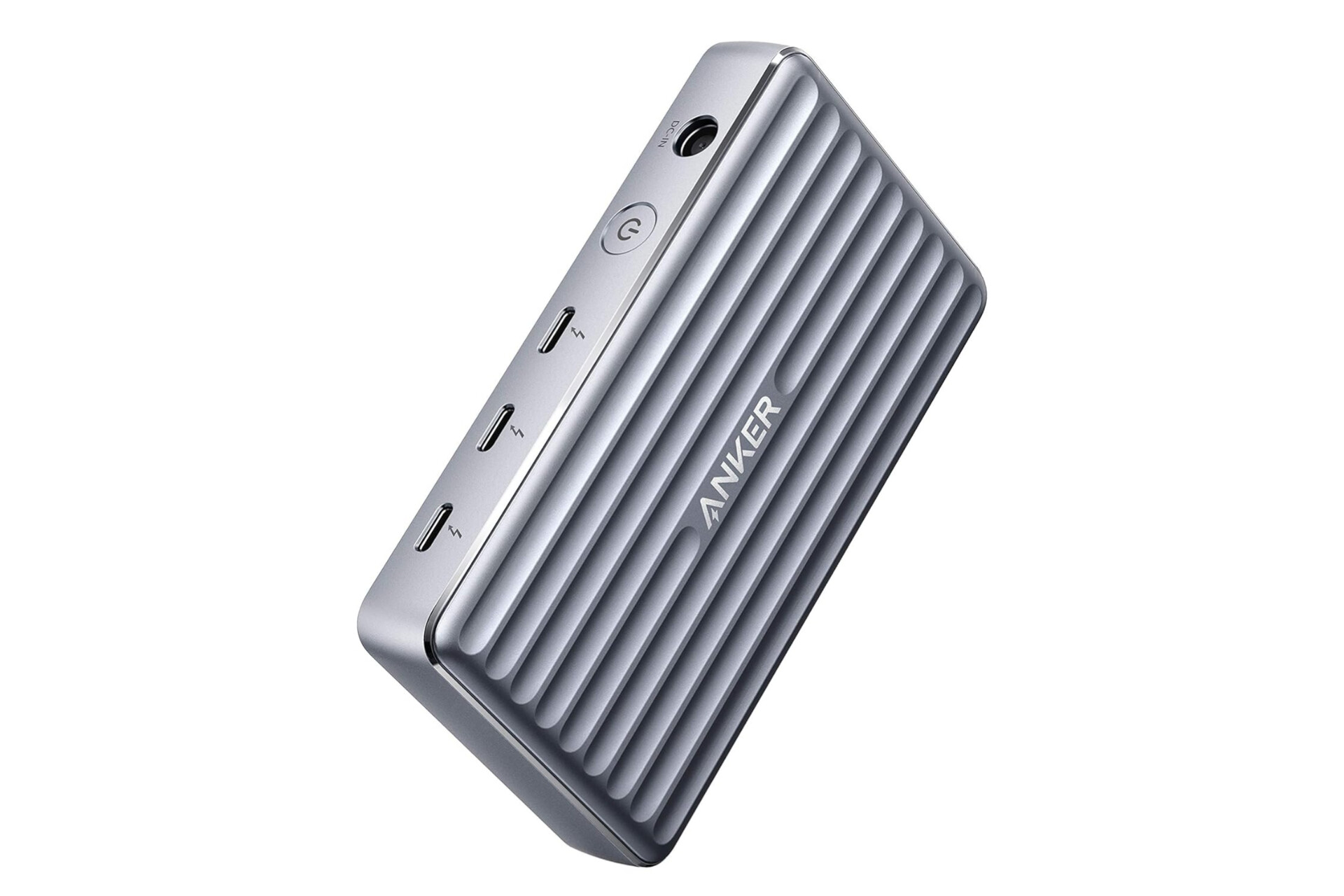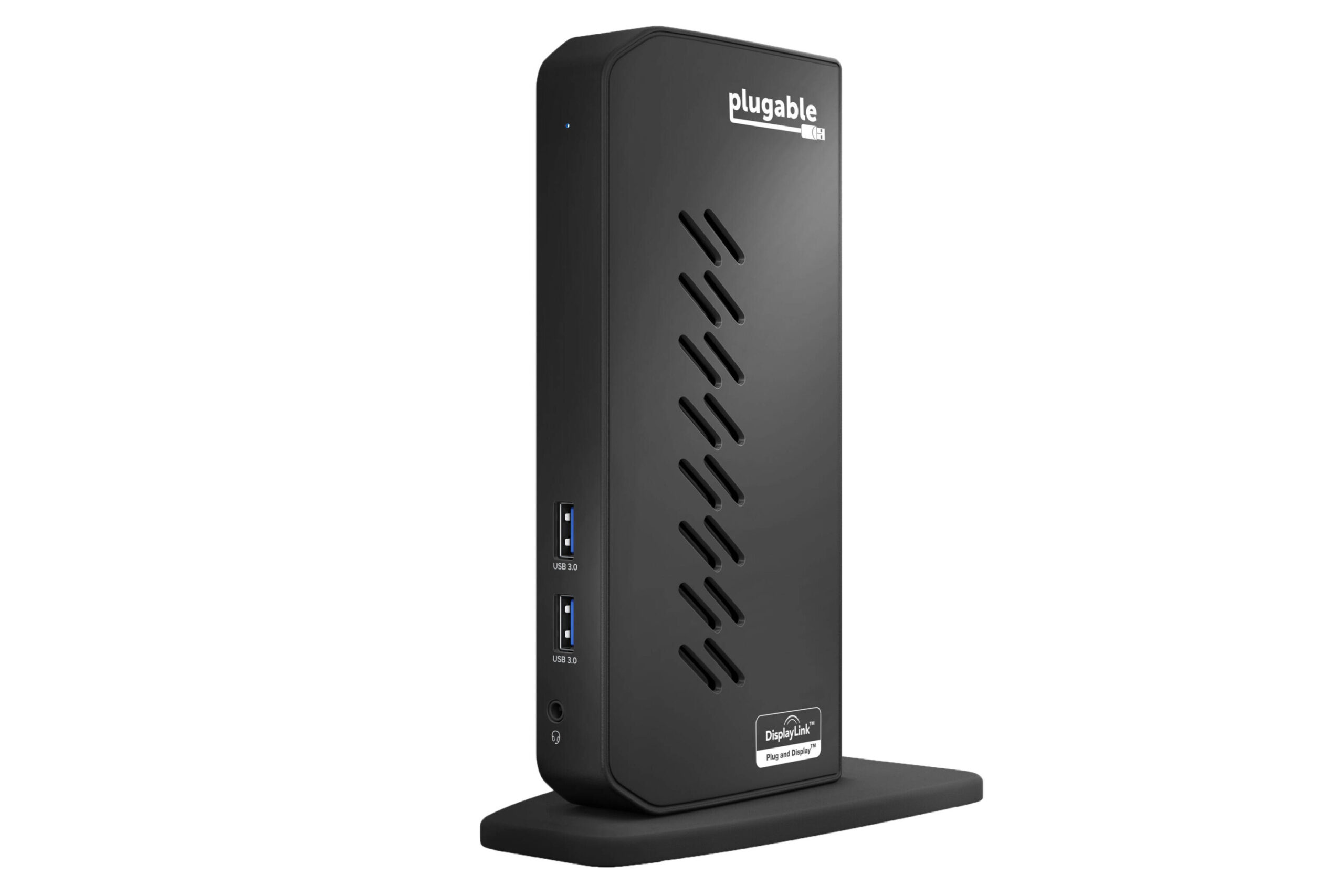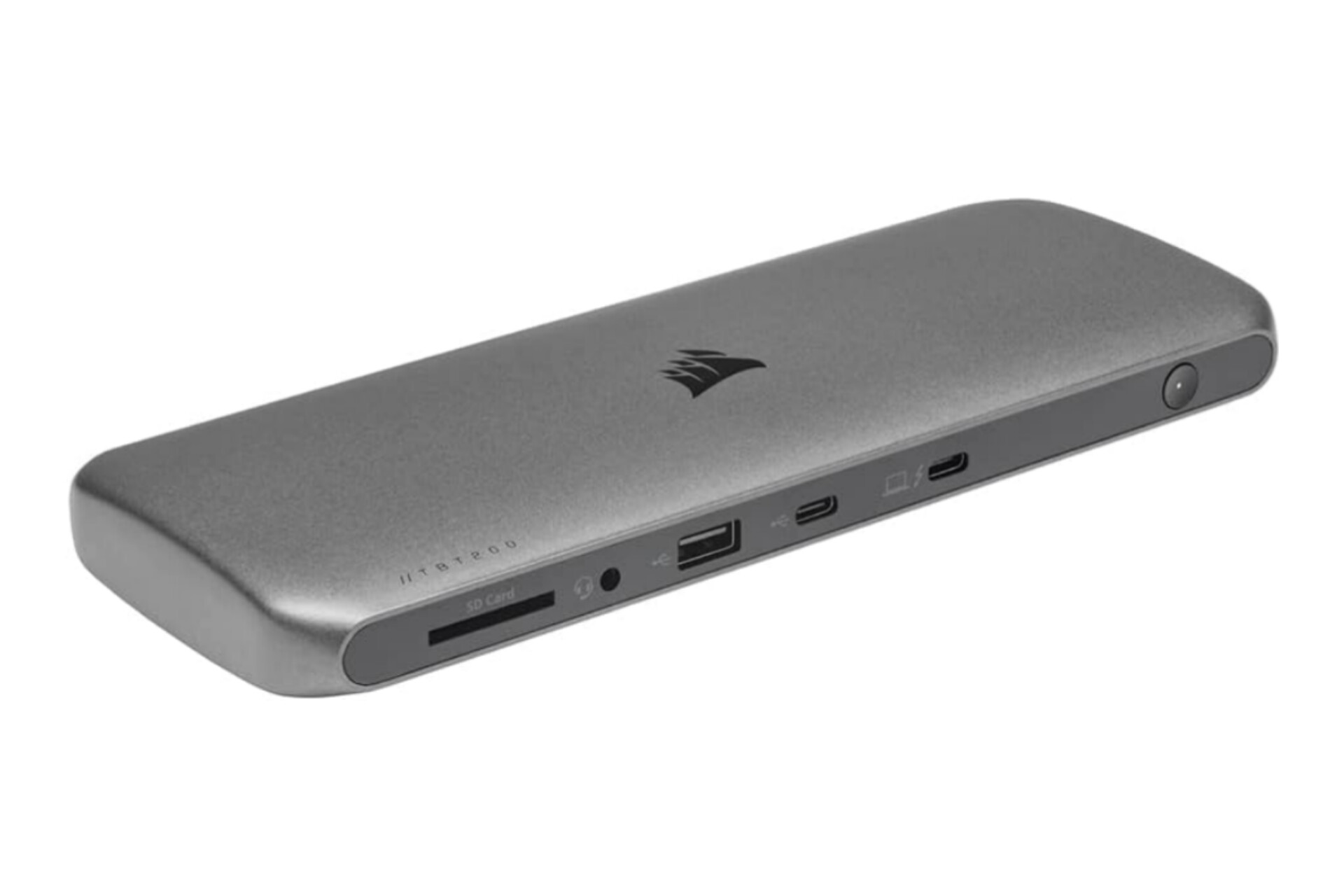Disclaimer: We may earn affiliate commission from qualifying purchases at no extra cost to you.
Welcome to our guide on the “5 Best Docking Stations of 2023.” In an era of remote work and versatile computing, these docking stations are your gateway to enhanced connectivity and productivity. Explore our top picks and find the perfect solution to elevate your workspace and streamline your workflow.

Anker Thunderbolt 4 Mini Dock

Plugable UD-3900Z

Razer Thunderbolt 4

Kensington SD5780T

Corsair TBT200

The first one on our list is Anker PowerExpand 5-in-1 Thunderbolt 4 Mini Dock. This docking station is one of the best in the market this year. Anker’s 5-in-1 Thunderbolt 4 docking station features power and super-fast connectivity in a limited package.
Looking at the design, The mini dock features the same aluminum grooves covering its top and bottom sides giving its thick frame a premium look and feel. Plus, Each port leaves enough space so cables don’t overcrowd the dock. What’s more, you’ll find the right ports placed on the most convenient side of the device. For example, the Thunderbolt 4 upstream port is at the front because it’s the easiest place to connect or disconnect your laptop. Then again, the power button is placed on the rear of the device, making it inconvenient to turn it on or off.
Anker’s mini docking station comes in at 0.5 pounds or 250 grams with dimensions of 4.9 x 2.8 x 0.9 inches. This is significantly smaller and lighter than the much larger Anker Apex Thunderbolt 4 Docking Station which weighs 1 pound. This could be seen more as a travel-friendly USB-C hub.
The most important aspect of a docking station is the connectivity it provides. On the front, the hub fits a Thunderbolt 4 upstream port with up to 40 Gbps transfer speeds and an impressive 85 watts for charging, which is mainly used to connect your laptop. Next to this is one USB-A 3.1 port with 10Gbps transfer speeds and 5 Volts for charging. Along the rear are three Thunderbolt 4 downstream ports offering 40 Gbps speeds, 15-Watt power, and up to 8K display resolution at 30Hz when connected to a monitor.
In terms of performance, it didn’t come as a surprise it could charge, transfer files, and connect to multiple devices without hesitation. However, the only downside is that the Anker PowerExpand 5-in-1 mini docking doesn’t have an SD card reader port and dual monitor support.
In short, the mini dock is a welcome companion for notebooks lacking ports, especially if you’re after more USB-C, Thunderbolt 3, and 4 connections. Additionally, it’s one of the most affordable hubs around if you’re in need of more Thunderbolt 4 options.

The next one on our list is the Plugable UD-3900Z Docking Station. This is another great option for those looking for a decent docking station to enhance their connectivity. The Plugable UD-3900Z is a USB 3.0 and USB-C dual HDMI monitor docking station that has room for six USB devices, Gigabit Ethernet, two 1920×1200 HD resolution monitors, and audio.
The vertical orientation is designed to reduce its desk footprint to give you more room for the things that matter most. With easily accessible ports on the front of the dock, you can unplug your headphones with ease.
This port is a general office workhorse that is designed for PC users that need more connectivity. The device doesn’t support Mac or Linux and has limited touchscreen compatibility. Essentially, if you do the normal office things and need to connect up to two monitors and a handful of other USB devices, UD-3900Z has you covered. One drawback is that the host connection is not-charging.
Performance-wise, the Plugable UD-3900Z universal Docking Station works as it should without any hiccups. We would have tested the docking station on a 4K Samsung TV, but because it doesn’t support HDMI 2.0, we couldn’t. It’s an annoying omission. Moreover, it does not charge your PC, and the SD card reader is missing as well.
Overall, There are many reasons why this 10 in 1 docking station has garnered much attention. Not only does this dock expand your connectivity, but it also brings a whole new level of performance and flexibility. By all accounts, this is a good docking station to buy.

The third one on our list is the Razer Thunderbolt 4 Dock. This docking station by Razer has the Bandwidth and Versatility You Desire. And the features and options it provides are just amazing.
Looking at the design, Razer’s Thunderbolt 4 Dock Chroma is made to sit horizontally on your desk. Razer has built RGB lighting into the bottom edges of the dock. Unlike some competing docks, the Thunderbolt 4 Dock Chroma doesn’t use plastic for the port-surrounding faceplates. The dock’s shell is all aluminum, and it has a matte black finish to match many other Razer products. There’s a Razer logo on the top, but it’s inconspicuous.
The Razer Thunderbolt 4 Dock Chroma is a fully-fledged docking station with 10 ports, including the latest Thunderbolt 4 and USB-4 connectivity standards. Razer positioned most of the ports along the back edge of the dock, reserving the front edge for the host Thunderbolt 4 port, 3.5mm audio jack, and UHS-II SD card reader. Some users prefer the host port to be on the back for easier long-term cable management, while others prefer it on the front for an easier connection. The back of the dock includes three downstream Thunderbolt 4 ports, Gigabit Ethernet, three USB-A 3.2 (Gen 2), and the AC adapter input.
In terms of performance, you will not be disappointed. you can plug a laptop straight into it and have immediate access to all other connected accessories, including external monitors. The dock can handle up to dual 4K displays, each with a 60Hz refresh rate, and we’ve also used the dock with all kinds of ultrawide, QHD, and FHD displays. As mentioned, the only drawback is having no native video out, but we were able to connect displays successfully via Thunderbolt 4 and an adapter.
Additionally, we tested up to about 13 watts of charging power with a phone connected. This is separate from the host charging capabilities which top out at 90 watts. It’s enough for most laptops excluding particularly power-hungry gaming and design machines. The Dock Chroma has just a one-year warranty which we consider a negative.
In a nutshell, Razer’s Thunderbolt 4 dock takes connectivity to the next level by adding RGB lighting to an already powerful accessory making it a top pick for gamers, but professionals can also take advantage of its strong performance.

The next one on our list is Kensington SD5780T Thunderbolt 4 Dock. Kensington has ironed out some wrinkles and delivered its best dock yet. Kensington’s Thunderbolt 4 Dual 4K Dock SD5780T essentially replaces the excellent Kensington SD5700T, both in the company’s product line and as one of the top picks among Thunderbolt docks we’ve reviewed.
The dock has a cool grey outer layer, made up of anodized aluminum with a fine-brushed finish. Its rounded sides are made up of grilled layers, with the left side sneakily hiding a signature Kensington security lock. On the bottom, you’ll find four small rubber feet that keep the docking station in place. The front-facing panel is what you’ll see the most of, and thankfully, it has nicely spaced-out ports so cables don’t get too cluttered. Physically, the Kensington SD5780T sits flat on your desk, measuring 0.95 pounds, with no vertical stand.
Looking at the connectivity, In total, the SD5780T offers four USB-A ports, two USB-C and two Thunderbolt 4 ports for downstream connectivity. Plus an HDMI 2.1 port, a 2.5Gb ethernet port, an SD 4.0 UHS-II SD card slot, and a 3.5-millimeter jack for a mic and headphones. Like the SD5700T, the dock includes a small power button and LEDs that light when the dock is powered and connected. Kensington supplies no dedicated USB-C ports on the SD5780T, but that’s not necessarily a negative.
For one, the front-mounted USB-A port supplies 1.5 Ampere for charging a smartphone. But the two other downstream Thunderbolt 4 ports provide 3 Ampere of current, which can fast-charge a smartphone. Our tests indicated that it generated 90 watts downstream to a connected laptop for charging –versus a rated 96 watts.
From a performance standpoint, the SD5780T dock performed very well when streaming a 4K video, dropping just a few frames. Plus, the SD5780T’s HDMI 2.1 port is ideal for those who prefer native video. In short, The SD5780T is a docking station that provides you with Solid performance without any thermal issues. Plus, it has a pretty solid mix of ports, including downstream Thunderbolt 4. The SD5780T met all our expectations. This is the best docking station for Thunderbolt 4 connectivity and beyond.

Last but not least, the Corsair TBT200 Thunderbolt 4 Dock is on our list as well. The latest dock from Corsair offers all the connectivity options in a small and well-built aluminum housing with rounded corners. Considering the 10 ports present on the TBT200, it is compact and slim. It looks and feels a bit like a metal pencil case. It fits nicely in the hand and any bag you need to carry it in. What’s a bit heavier and more cumbersome, though, is its power supply, which features a pretty hefty power brick. The cable is nice and long, though. This 150-watt power supply not only powers the dock but can also provide 96-watt power to your laptop.
On the front is a UHS-II SD Card 4.0 reader capable of speeds up to 312 MB per second, a 3.5mm audio port, a USB Type-A port capable of up to 7.5-Watt charging, 10Gbps Type-C port capable of 15-Watt charging, Thunderbolt 4 port (40Gbps) to plug into your PC or laptop and a power switch. The Type-C port that connects to your laptop.
On the back, we have the 100-watt power adapter port, three more 40Gbps Thunderbolt 4 ports, a 2.5G ethernet port, and two more Type-A ports. included with the TBT200 is a 2.5-foot-long Thunderbolt 4 cable, Type-C to HDMI, and Type-C to Display Port cable. The TBT200 has HDMI 2.0 and is capable of two displays up to 4K@60 Hertz, including the laptop monitor itself.
From the performance point of view, It truly is a case of plug-in and play. There are no drivers or software to install. We tried it out with a range of devices, and everything worked seamlessly. Having the connection to the computer on the front, and the other Thunderbolt 4 ports on the back, makes a lot of sense and helps reduce clutter and chaos on the desk.
To conclude, It may be expensive, but the Corsair TBT200 is basically the Rolls Royce of docking stations. You get 10 ports in total, plus passthrough charging, support for Thunderbolt 4, and the ability to connect two 4K monitors at once, at 60fps. All in a light and portable aluminum box that’s easy to set up and use.
Docking stations are essential accessories for anyone who uses a laptop or tablet as their primary computing device. These devices provide a convenient way to expand your laptop’s connectivity options, turning it into a versatile workstation. In 2023, there will be numerous docking stations available on the market, each offering unique features and capabilities. To help you make an informed decision, we have compiled a buying guide for the 5 best docking stations of 2023.
Considerations when Buying a Docking Station:
Before diving into the specific products, it’s essential to understand the key factors to consider when choosing a docking station:
1. Compatibility:
Ensure that the docking station you choose is compatible with your laptop or tablet. Most docking stations are designed for specific brands or models, so check for compatibility lists provided by the manufacturer.
2. Ports and Connectivity:
Evaluate your connectivity needs. The number and types of ports on the docking station matter. Common ports include USB-C, USB-A, HDMI, DisplayPort, Ethernet, and audio jacks. Choose a docking station that offers the ports you require for your peripherals.
3. Power Delivery:
If you want to charge your laptop while connected to the docking station, look for one with Power Delivery (PD) capabilities. It should provide sufficient wattage to charge your laptop adequately.
4. Display Support:
Consider the number of external displays you plan to connect. Some docking stations support multiple monitors, while others may only support one. Also, check the maximum resolution supported for each display.
5. Build Quality and Design:
The build quality and design of the docking station are important, especially if you plan to use it daily. Look for a durable and aesthetically pleasing design that suits your workspace.
Conclusion:
Before making your final decision, be sure to read user reviews, compare prices, and verify that the docking station you choose meets your specific requirements. A well-chosen docking station can significantly enhance your productivity and connectivity, making it a valuable addition to your setup in 2023.

![Best Docking Stations 2023 [For Laptop & Macbook]](https://foremostpicks.com/wp-content/uploads/2023/09/4Ysuv7Q1Q6Y-HD.jpg)